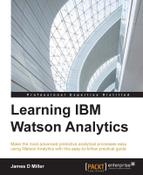Book Description
Make the most advanced predictive analytical processes easy using Watson Analytics with this easy-to-follow practical guide
About This Book
- This is the first and the only book on IBM Watson Analytics, and it shows you how to leverage Watson in an enterprise environment through rich use cases
- Incorporate Watson Analytics into your business strategy and confidently add this cutting edge expertise to your resume
- This book is written by James D Miller, IBM-certified expert and accomplished Director and Sr. Project Leader
Who This Book Is For
If you want to perform data discovery and analysis and make sense of data you have, this book for you. Data scientists can also use this book to explore a new way to perform data analysis tasks on cloud with ease. This book does not require a programming background.
What You Will Learn
- Study the language of Watson while you discover how easy it is to access and configure
- Review what a Watson use case is, why it's important, and how to identify one
- Design Watson Analytical solutions based upon your use cases
- Understand the basic concepts behind the content analysis cycle and where Watson fits in
- Explore all the features of Watson, such as Explore, Predict, and Assemble
- Customize and extend your Watson solutions
- Use Watson at the Enterprise level
- Integrate Watson with other toolsets
In Detail
Today, only a small portion of businesses actually use a real analytical tool as part of routine decision making. IBM Watson Analytics is changing that making the most advanced and predictive analytical techniques understandable and usable for any industry.
This book will be the vital tour guide for your trip, starting with what IBM Watson Analytics is. We'll start off with introduction to Watson Analytics and then quickly move on to various use cases under which one can use the different analytics functionalities offered by Watson. During the course of the book, you will learn how to design solutions, and customize and extend Watson analytics. We will conclude by taking Watson Analytics to enterprise and integrating it with other solutions (other IBM solutions and analytics). Now is the time for you to learn IBM Watson to compete in the world.
Style and approach
Watson provides individuals with the ability to perform sophisticated data discovery and analysis without all of the complexity that usually goes along with it. This book will get you started with Watson analytics and how you can use it in day-to-day data analysis. The book introduces the key concepts and terminology and then uses practical use case examples to reinforce your understanding.
